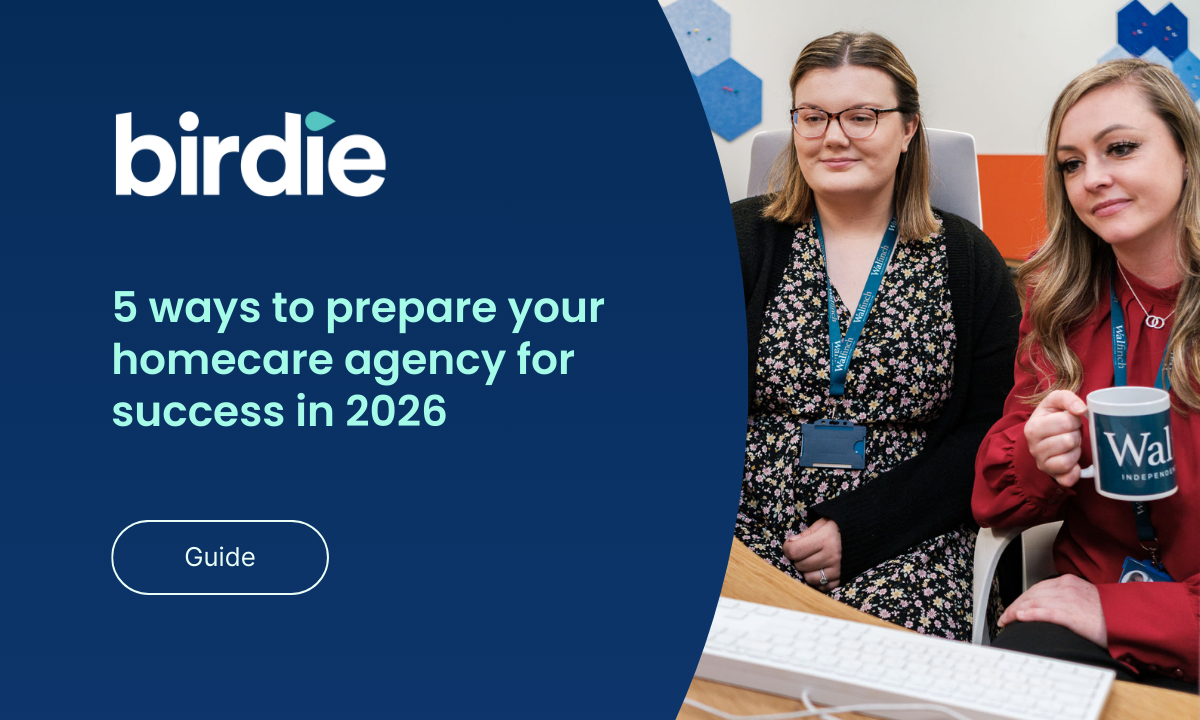Table of contents
Domiciliary care businesses face the unique challenge of delivering the best standards of care to clients while ensuring the most efficient use of their care professionals' time. This means owners and registered managers of domiciliary care services must take proactive steps to improve the efficiency of their care visits. This article looks at some of those steps you can take today to get your visit efficiency in the best shape yet!
Optimising Care Visit Schedules
Efficient scheduling in the domiciliary care sector can sometimes feel like conducting an orchestra in a thunderstorm! It's a multifaceted challenge that involves not only ensuring that each care recipient receives the right care at the right time, takes into account the practical aspects of travel and care professional availability and leaves room for client emergencies and shift covering.
Efficient route planning is an essential part of this, grouping appointments in geographic clusters to minimize travel time and having a clear understanding of how much time each care professional needs between visits. Equally important is effective time management, where care professionals prioritise tasks during visits and are able to focus on essential care activities.
Some ways to action this optimisation include offering flexible working hours allows care professionals to align their shifts with their availability, reducing the need for last-minute adjustments. Providing an efficient way to communicate updates or changes with care professionals is also key. On the care recipient side, regular schedule reviews, training programs, and clear communication about their visit schedules contribute to a more streamlined and efficient scheduling process.
This is a lot to achieve, and almost impossible to do manually - so one good place to start is researching dedicated rostering platforms tailored to the domiciliary care sector. These tools have the potential to revolutionise how you plan and manage care visits, making your scheduling process more efficient and responsive to changing circumstances.
Modern domiciliary care is increasingly reliant on technology to streamline operations - but much of this technology has come a long way in the past five years and can really make the difference when properly invested in. Imagine care professionals equipped with mobile apps that provide real-time access to rotas and care plans and facilitate instant communication with head office. This not only saves time and improves audit trails, but also empowers care professionals to deliver more personalised and effective care.
Enhancing Care Professional Training
Achieving ‘efficiency’ in domiciliary care doesn’t mean reducing hours and cutting costs - it all begins with a well-trained team who understand the
significance of effective time management. Care providers should prioritize regular training sessions that go beyond core care skills and delve into techniques for optimizing visit efficiency. These training sessions can cover a range of essential topics, including rapid yet thorough assessment methods to quickly understand care recipient needs, task prioritisation during visits to ensure critical care activities are addressed promptly, and best practices for providing effective domiciliary care.
To kickstart the journey towards enhanced visit efficiency, the actionable point is to take the initiative and schedule regular training sessions specifically designed to improve both the efficiency and quality of care delivery. This investment in your care professionals will undoubtedly yield dividends in terms of improved visit efficiency and overall service quality. It also makes the working lives of your professionals better, as they get more time back to spend bonding with care recipients instead of rushing around to complete tasks. To access a wealth of training resources tailored to the domiciliary care sector, visit Skills for Care, where you can find valuable materials and guidance to support your training initiatives.
Implementing Standardised Visit Protocols
What are standardised visit protocols? It means having a set of guiding principles that are relevant to every care visit, ensuring that essential tasks are consistently and comprehensively performed, regardless of the care professional involved. By adhering to standardised protocols across your different services, care providers can enhance both the efficiency and quality of care delivery.
To initiate the process of implementing standardised visit protocols, sit down with your care team to identify the critical components of a successful care visit and develop a standardised checklist from this discussion. These checklists then serve as invaluable tools that help care professionals manage their time effectively while upholding a consistent standard of care. It's essential to tailor these protocols to the specific needs and preferences of your domiciliary care business, ensuring that they align with your unique service model and the expectations of your care recipients.
To further facilitate this process, it's crucial to make these standardised visit protocols readily accessible to all care professionals within your organisation. Every care professional should have easy access to these protocols and be diligent in following them during their visits. Consistency in care delivery not only improves efficiency but also contributes to a higher quality of care and greater recipient satisfaction. Make this much easier by using care management platforms that feature task creation and care planning that can be customised to match your standardised visit protocols.
If you’re not ready to get the team together yet, start by studying existing protocols used in the domiciliary care sector for inspiration and guidance in creating your standardised visit protocols. These established protocols can offer valuable insights into best practices and can serve as a foundation for developing your own customised checklists.
Fostering Effective Communication with Care Recipients
The practice of communicating clearly and consistently with care recipients not only sets clear expectations but also builds trust and ensures that care visits run smoothly. To achieve this, care providers should establish and maintain clear and consistent channels of communication with care recipients.
The first step towards enhancing communication is to provide care recipients with an information pack that includes their visit schedules, care plans, and what they can expect during each visit. This proactive approach empowers care recipients by keeping them well-informed, which in turn enhances visit efficiency and recipient satisfaction. When care recipients are aware of the timing and purpose of their visits, it reduces potential confusion and contributes to a more efficient care delivery process.
It’s not just ensuring care recipients have access to relevant information - but also that they feel comfortable discussing their care needs, preferences, and any concerns they may have. Open and transparent communication fosters a sense of trust and partnership between care recipients and care professionals, creating an environment where care visits can be conducted with efficiency and empathy.
As a first step here, consider exploring communication guides and best practices within the domiciliary care sector. These resources can provide valuable insights and tips on refining your interactions with care recipients, ensuring that your communication is effective, compassionate, and conducive to efficient care visits.
By delving deeper into these strategies, domiciliary care providers can take concrete steps towards improving visit efficiency, ultimately benefiting both care recipients and care professionals. Embracing digital tools and cultivating a culture of efficiency can lead to a more successful and sustainable domiciliary care business.
Want to read more on this? Click the button below to read our article ‘How to cut down on wasted time'.
.svg)
Published date:
April 9, 2024
Author:
Lucy Rollinson-Ogilvie

.png)
















.svg)